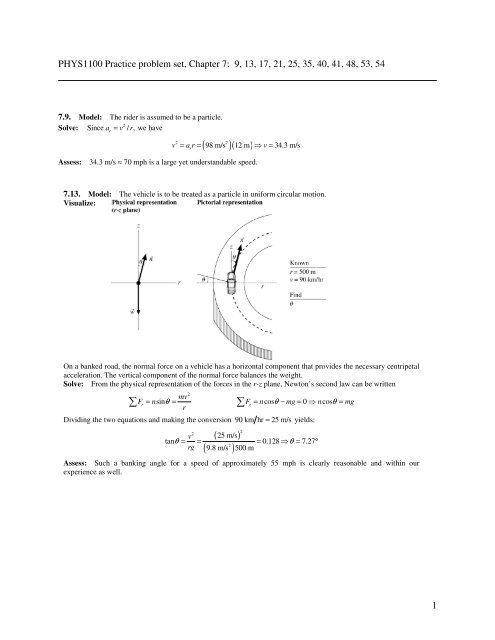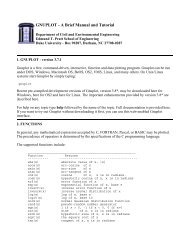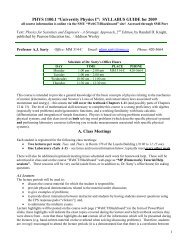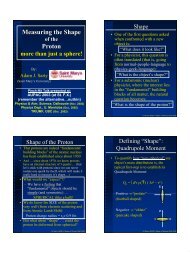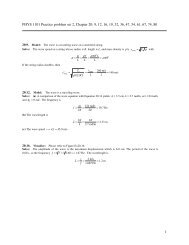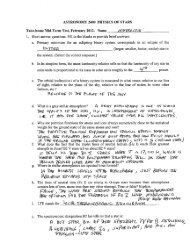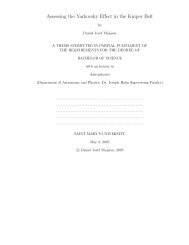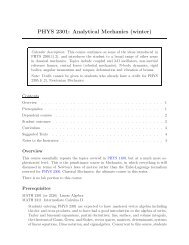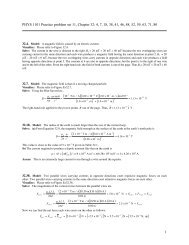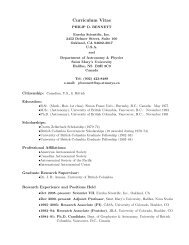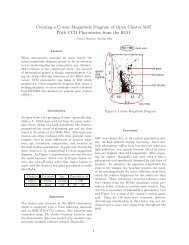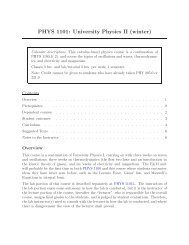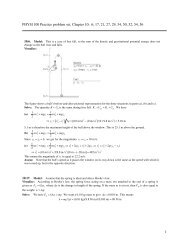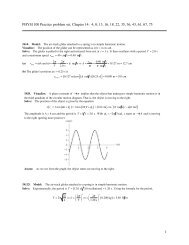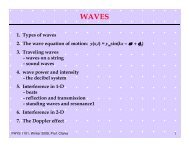1 PHYS1100 Practice problem set, Chapter 7: 9, 13, 17, 21, 25, 35 ...
1 PHYS1100 Practice problem set, Chapter 7: 9, 13, 17, 21, 25, 35 ...
1 PHYS1100 Practice problem set, Chapter 7: 9, 13, 17, 21, 25, 35 ...
You also want an ePaper? Increase the reach of your titles
YUMPU automatically turns print PDFs into web optimized ePapers that Google loves.
<strong>PHYS1100</strong> <strong>Practice</strong> <strong>problem</strong> <strong>set</strong>, <strong>Chapter</strong> 7: 9, <strong>13</strong>, <strong>17</strong>, <strong>21</strong>, <strong>25</strong>, <strong>35</strong>, 40, 41, 48, 53, 54<br />
7.9. Model: The rider is assumed to be a particle.<br />
2<br />
Solve: Since a = v / r, we have<br />
r<br />
( )( )<br />
v = a r = 98 m/s 12 m ⇒ v = 34.3 m/s<br />
2 2<br />
r<br />
Assess: 34.3 m/s ≈ 70 mph is a large yet understandable speed.<br />
7.<strong>13</strong>. Model: The vehicle is to be treated as a particle in uniform circular motion.<br />
Visualize:<br />
On a banked road, the normal force on a vehicle has a horizontal component that provides the necessary centripetal<br />
acceleration. The vertical component of the normal force balances the weight.<br />
Solve: From the physical representation of the forces in the r-z plane, Newton’s second law can be written<br />
2<br />
mv<br />
∑ Fr<br />
= nsinθ<br />
=<br />
∑ Fz<br />
= ncosθ<br />
− mg = 0 ⇒ ncosθ<br />
= mg<br />
r<br />
Dividing the two equations and making the conversion 90 km hr = <strong>25</strong> m/s yields:<br />
( <strong>25</strong> m/s)<br />
2<br />
( )<br />
2<br />
2<br />
v<br />
tanθ<br />
= = = 0.128 ⇒ θ = 7.27°<br />
rg 9.8 m/s 500 m<br />
Assess: Such a banking angle for a speed of approximately 55 mph is clearly reasonable and within our<br />
experience as well.<br />
1
7.<strong>17</strong>. Model: The satellite is considered to be a particle in uniform circular motion around the moon.<br />
Visualize:<br />
Solve: The radius of moon is 1.738 × 10 6 m and the satellite’s distance from the center of the moon is the same<br />
quantity. The angular velocity of the satellite is<br />
and the centripetal acceleration is<br />
ar<br />
2π<br />
2π<br />
rad 1min<br />
ω = = × = ×<br />
T 110 min 60 s<br />
−4<br />
9.52 10 rad/s<br />
−<br />
( )( ) 2<br />
= rω = 1.738 × 10 m 9.52 × 10 rad/s = 1.58 m/s<br />
2 6 4 2<br />
The acceleration of a body in orbit is the local “g” experienced by that body.<br />
7.<strong>21</strong>. Model: Model the roller coaster car as a particle undergoing uniform circular motion along a loop.<br />
Visualize:<br />
Notice that the r-axis points downward, toward the center of the circle.<br />
Solve: In this <strong>problem</strong> the apparent weight is equal to the weight: wapp = n = mg.<br />
We have<br />
2<br />
mv<br />
2<br />
∑ Fr<br />
= n + w = = mg mg v rg ( )( )<br />
r<br />
+ ⇒ = 2 = 2 20 m 9.8 m/s = 19.8 m/s<br />
2
7.<strong>25</strong>. Model: Model the particle on the crankshaft as being in nonuniform circular motion.<br />
Visualize:<br />
Solve: (a) The initial angular velocity is ω 0 = <strong>25</strong>00 rpm × (1 min/60 s) × (2π rad/rev) = 261.8 rad/s. The<br />
crankshaft slows from 261.8 rad/s to 0 in 1.5 s. Thus<br />
ω<br />
a<br />
rω<br />
(0.015 m)(261.8 rad/s)<br />
t<br />
0<br />
2<br />
1<br />
= 0 = ω0 + t1<br />
⇒ at<br />
= − = − = –2.618 m/s<br />
r<br />
t1<br />
1.5 s<br />
(b) During these 1.5 s, the crankshaft turns through angle<br />
2<br />
a 2 2.618 m/s<br />
2<br />
1 0 0t<br />
t<br />
1<br />
t1<br />
θ = θ + ω + = 0 + (261.8 rad/s) (1.5 s) − (1.5 s) = 196.3 rad<br />
2r<br />
2(0.015 m)<br />
In terms of revolutions, θ 1 = (196.3 rad)(1 rev/2π rad) = 31.<strong>25</strong> rev.<br />
3
7.<strong>35</strong>. Model: We will use the particle model for the car, which is undergoing uniform circular motion on a<br />
banked highway, and the model of static friction.<br />
Visualize:<br />
Note that we need to use the coefficient of static friction µ s , which is 1.0 for rubber on concrete.<br />
Solve: Newton’s second law for the car is<br />
mv<br />
r<br />
2<br />
∑ F cos sin<br />
r<br />
= fs θ + n θ =<br />
z<br />
θ<br />
s<br />
∑ F = ncos − f sinθ<br />
− w = 0 N<br />
Maximum speed is when the static friction force reaches its maximum value fs max<br />
= µ<br />
s<br />
n.<br />
Then<br />
2<br />
cos15 sin15 mv<br />
n<br />
s<br />
r<br />
Dividing these two equations and simplifying, we get<br />
Assess:<br />
( µ ° + ° ) = n( cos15 µ<br />
s<br />
sin15 )<br />
µ 2<br />
s<br />
tan15 v<br />
µ s<br />
+ ° + tan15°<br />
= ⇒ v = gr<br />
1− µ tan15° gr 1− µ tan15°<br />
s<br />
( )( ) ( 1.0 + 0.268 )<br />
2<br />
( 1−<br />
0.268)<br />
= 9.80 m/s 70 m = 34.5 m/s<br />
The above value of 34.5 m/s ≈ 70 mph is reasonable.<br />
s<br />
° − ° = mg<br />
4
7.40. Model: Use the particle model for the ball which is in uniform circular motion.<br />
Visualize:<br />
Solve:<br />
From Newton’s second law along r and z directions,<br />
Dividing the two force equations gives<br />
2<br />
mv<br />
∑ Fr<br />
= ncosθ<br />
= ∑ Fz<br />
= nsinθ<br />
− mg = 0 ⇒ nsinθ<br />
= mg<br />
r<br />
From the geometry of the cone, tan θ = r y.<br />
Thus<br />
gr<br />
tanθ =<br />
2<br />
v<br />
r gr<br />
= ⇒ v =<br />
2<br />
y v<br />
gy<br />
5
7.41. Model: Consider the passenger to be a particle and use the model of static friction.<br />
Visualize:<br />
Solve: The passengers stick to the wall if the static friction force is sufficient to support their weight: f s = w. The<br />
minimum angular velocity occurs when static friction reaches its maximum possible value f s max = µ s n. Although<br />
clothing has a range of coefficients of friction, it is the clothing with the smallest coefficient (µ s = 0.6) that will slip<br />
first, so this is the case we need to examine. Assuming that the person is stuck to the wall, Newton’s second law is<br />
∑<br />
The minimum frequency occurs when<br />
Using this expression for f s in the z-equation gives<br />
s<br />
∑<br />
2<br />
Fr<br />
= n = mω<br />
r Fz<br />
= fs<br />
− w = 0 ⇒ fs<br />
= mg<br />
f = f = µ n = µ mrω<br />
2<br />
s s max s s min<br />
f = µ mrω<br />
= mg<br />
2<br />
s s min<br />
2<br />
g 9.80 m/s 1 rev 60 s<br />
⇒ ωmin<br />
= = = 2.56 rad/s = 2.56 rad/s × × = 24.4 rpm<br />
µ r 0.60(2.5 m) 2 π rad 1 min<br />
Assess: Note the velocity does not depend on the mass of the individual. Therefore, the minimum mass sign is<br />
not necessary.<br />
6
7.48. Model: Model the chair and the rider as a particle in uniform circular motion.<br />
Visualize:<br />
Solve:<br />
Since<br />
Newton’s second law along the r-axis is<br />
∑<br />
r = Lsinθ<br />
, this equation becomes<br />
F = T + w = ma<br />
r r r r<br />
2<br />
⇒ T sinθ<br />
+ 0 N = mrω<br />
Thus, the 3000 N chain is not strong enough for the ride.<br />
2 ⎡ 2π<br />
rad ⎤<br />
T = mLω<br />
= ( 150 kg)( 9.0 m)<br />
⎢ = 3330 N<br />
4.0 s<br />
⎥<br />
⎣ ⎦<br />
2<br />
7
7.53. Model: Model the car as a particle on a circular track.<br />
Visualize:<br />
Solve: (a) Newton’s second law along the t-axis is<br />
F F ma<br />
2<br />
∑ t<br />
=<br />
t<br />
=<br />
t<br />
⇒ 1000 N = ( 1500 kg) at<br />
⇒ at<br />
= 2 3 m/s<br />
With this tangential acceleration, the car’s tangential velocity after 10 s will be<br />
The radial acceleration at this instant is<br />
2<br />
( ) ( )( )<br />
v1 t<br />
= v0t + at<br />
t1 − t0 = 0 m s + 2 3 m/s 10 s − 0 s = 20 3 m/s<br />
( ) 2<br />
2<br />
v 20 3 m/s<br />
1t<br />
16 m/s<br />
2<br />
ar<br />
= = =<br />
r <strong>25</strong> m 9<br />
The car’s acceleration at 10 s has magnitude<br />
2 2<br />
2 2 2 2 2<br />
−1 at<br />
−1⎛ 2 3 ⎞<br />
a1 = at<br />
+ ar<br />
= ( 2 3 m/s ) + ( 16 9 m/s ) = 1.90 m/s θ = tan = tan ⎜ ⎟ = 20.6°<br />
ar<br />
⎝ 16 9 ⎠<br />
where the angle is measured from the r-axis.<br />
(b) The car will begin to slide out of the circle when the static friction reaches its maximum possible value<br />
f = µ n . That is,<br />
s max<br />
s<br />
2<br />
mv2<br />
t<br />
2<br />
∑ Fr<br />
= fs max<br />
= µ<br />
sn = µ<br />
smg<br />
= v<br />
t<br />
rg ( )( )<br />
r<br />
⇒<br />
2<br />
= = <strong>25</strong> m 9.8 m/s = 15.7 m/s<br />
In the above equation, n = mg follows from Newton’s second law along the r-axis. The time when the car begins to<br />
slide can now be obtained as follows:<br />
= + ( − ) ⇒ 15.7 m/s 0 m s ( 2 3 m/s 2<br />
)( t 0) 2<br />
v v a t t<br />
2t 0t t 2 0<br />
= + − ⇒ t2 = 23.5 s<br />
2<br />
8
7.54. Model: Model the steel block as a particle and use the model of kinetic friction.<br />
Visualize:<br />
Solve:<br />
(a) The components of thrust ( F r ) along the r-, t-, and z-directions are<br />
Fr<br />
Newton’s second law is<br />
= F sin20° = ( 3.5 N)<br />
sin20° = 1.20 N F F ( )<br />
2<br />
( F ) T F mrω<br />
net<br />
r<br />
= + = ( )<br />
r<br />
( )<br />
net<br />
t<br />
= cos20° = 3.5 N cos20° = 3.29 N F z = 0 N<br />
F = F − f = ma<br />
net<br />
F = n − mg = 0 N<br />
The z-component equation means n = mg. The force of friction is<br />
z<br />
2<br />
( )( )( )<br />
fk = µ<br />
kn = µ<br />
kmg<br />
= 0.60 0.5 kg 9.8 m/s = 2.94 N<br />
Substituting into the t-component of Newton’s second law<br />
2<br />
( 3.29 N) − ( 2.94 N) = ( 0.5 kg) a ⇒ a = 0.70 m/s<br />
Having found a t , we can now find the tangential velocity after 10 revolutions = 20π rad as follows:<br />
1 ⎛ a ⎞ 2rθ<br />
θ = t ⇒ t = = 18.95 s<br />
t 2 1<br />
1 ⎜ ⎟ 1 1<br />
2 ⎝ r ⎠<br />
at<br />
⎛ at<br />
⎞<br />
ω1 = ω0 + ⎜ ⎟ t<br />
1<br />
= 6.63 rad/s<br />
⎝ r ⎠<br />
(b) Substituting ω 1 into the r-component of Newton’s second law yields:<br />
T F mrω ⇒ T + 1.20 N = 0.50 kg 2.0 m 6.63 rad/s ⇒ T = 42.8 N<br />
+ = ( ) ( )( )( ) 2<br />
2<br />
1 r 1<br />
1 1<br />
t<br />
t<br />
t<br />
t<br />
k<br />
t<br />
9


